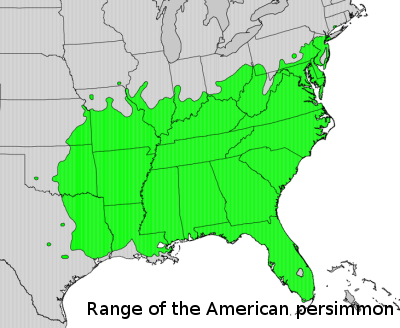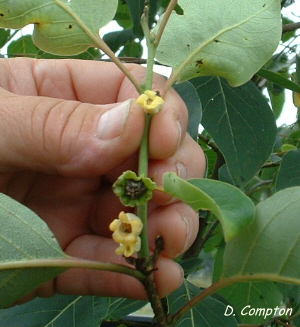
Planting persimmons
 Both American
and Asian persimmons can be tricky to grow, which in part explains
their absence from many permaculturalists' gardens. Although you
can buy named persimmon varieties from nurseries, you're taking a big
chance since persimmons put down a long taproot and hate to be
transplanted. In addition, Gene Logsdon reports that persimmon
seeds germinate better and trees transplant better into forest soil
rather than into garden soil, suggesting to me that there may be some
kind of soil microorganism the tree needs to associate with in order to
grow well. From
all I've read, your best bet for growing persimmons is to mimick
natural conditions, gathering wild seeds and planting them into a wild
habitat.
Both American
and Asian persimmons can be tricky to grow, which in part explains
their absence from many permaculturalists' gardens. Although you
can buy named persimmon varieties from nurseries, you're taking a big
chance since persimmons put down a long taproot and hate to be
transplanted. In addition, Gene Logsdon reports that persimmon
seeds germinate better and trees transplant better into forest soil
rather than into garden soil, suggesting to me that there may be some
kind of soil microorganism the tree needs to associate with in order to
grow well. From
all I've read, your best bet for growing persimmons is to mimick
natural conditions, gathering wild seeds and planting them into a wild
habitat.
In tomorrow's post, I'll
run through all of the tricks I've read about for getting your
persimmons to sprout and grow, but there are a few other things to
consider as you plan your planting. On the positive side, once
that seedling sprouts or that transplant puts down new roots,
persimmons can live quite well in poor soil, seeming to thrive in just
about every soil type out there. The trees will grow in the shade
(although they need sun to fruit), so you can get away with starting
them in a small gap in existing forest, opening up the canopy bit by
bit as your persimmon tree grows.

Keep in mind that
persimmons are large trees, requiring at least 30 feet spacing, and
that most trees are either male or female. Although you might get
lucky and find a variety that is self-pollinating (like the one in the
photo to the left), in general you should plan to plant at least one
male for every twelve female persimmons.
Finally, be aware that
there are two races of American persimmons and that the races can't
interbreed. The tetraploid race, with 60 chromosomes, is found in
the
southern Appalachians while the hexaploid race, with 90 chromosomes,
grows further north and west. In general, the latter has larger
fruits
that ripen earlier and has wider, more fuzzy leaves. If you're
going to try to start an orchard from seed, you may want to include
both races to extend your harvest, in which case you'll need to be sure
to plant both a tetraploid and a hexaploid male to pollinate your
females.
As a final side note,
persimmon flowers are reportedly beloved by bees. Maybe that will
push a few beekeepers over the edge into including persimmons in their forest pastures.
| This post is part of our Persimmons lunchtime series.
Read all of the entries: |
Want more in-depth information? Browse through our books.
Or explore more posts by date or by subject.
About us: Anna Hess and Mark Hamilton spent over a decade living self-sufficiently in the mountains of Virginia before moving north to start over from scratch in the foothills of Ohio. They've experimented with permaculture, no-till gardening, trailersteading, home-based microbusinesses and much more, writing about their adventures in both blogs and books.
Want to be notified when new comments are posted on this page? Click on the RSS button after you add a comment to subscribe to the comment feed, or simply check the box beside "email replies to me" while writing your comment.
